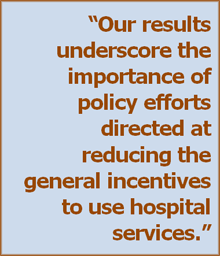Synopsis
In a study that examined variation in hospital readmission rates among Medicare beneficiaries, high rates of rehospitalization were found to be significantly associated with high overall hospital admission rates. This suggests that efforts to reduce readmissions must look beyond improving discharge planning and transitional care and also focus on lessening incentives for hospital use.
The Issue
Rehospitalization of patients is a costly problem. Efforts to reduce unplanned hospital readmissions are primarily focused on improving discharge planning and transitional care, but high readmission rates reflect broader, systemic issues. This Commonwealth Fund–supported study examined rehospitalization rates for Medicare patients with congestive heart failure and pneumonia discharged in different U.S. regions, while also looking at other variables, like overall hospitalization rates, differences in patients’ coexisting conditions, quality of discharge planning, and the number of hospital beds and physicians, to see how each factor affected readmissions.
Key Findings
- Rehospitalization rates for congestive heart failure varied by region, ranging from 11 percent to 32 percent, while readmission rates for pneumonia varied from 8 percent to 27 percent.
- Of all the potential causes for regional differences in readmission rates, overall hospital admission rates played the biggest role, accounting for 16 percent to 24 percent of the variation in cases of congestive heart failure and 11 percent to 20 percent for pneumonia cases. No other factor accounted for more than 6 percent of the variation.
- If all-cause admission rates of hospital referral regions in the upper quintile of hospital use were reduced to the rate of regions in the lowest quintile, the readmission rate for congestive heart failure would be reduced from 24.6 percent to 21.2 percent. For pneumonia, the study found the readmission rate would be reduced from 17.9 percent to 15.5 percent.
- Hospital referral regions with high readmission rates were more likely to have medium-sized or large hospitals and to be located in the Northeast.
Addressing the Problem
 Policies designed to reduce readmission rates for congestive heart failure or pneumonia must extend beyond a focus on transitions in care between the hospital and ambulatory care settings. Although these efforts will probably prevent some readmissions, it is equally important to focus on reducing general incentives to use hospital services. Policy initiatives that rely on shared savings and other means of promoting efficiency—like accountable care organizations—may be effective in lowering readmission rates and reducing the overall cost of care, the authors conclude.
Policies designed to reduce readmission rates for congestive heart failure or pneumonia must extend beyond a focus on transitions in care between the hospital and ambulatory care settings. Although these efforts will probably prevent some readmissions, it is equally important to focus on reducing general incentives to use hospital services. Policy initiatives that rely on shared savings and other means of promoting efficiency—like accountable care organizations—may be effective in lowering readmission rates and reducing the overall cost of care, the authors conclude.
About the Study
The authors used 2008 data from Medicare, the Dartmouth Atlas, and the Hospital Consumer Assessment of Healthcare Providers and Systems to compare readmission rates among patients with congestive heart failure or pneumonia by hospital referral region to determine whether regional variation was attributable to a regional propensity to hospitalize patients, patients’ coexisting conditions, quality of discharge planning, physician supply, or bed supply. The study looked at 306 referral regions that included more than 4,000 hospitals.
Bottom Line
Higher readmission rates for patients with congestive heart failure or pneumonia are associated with overall admission rates, suggesting interventions to reduce readmissions should focus on reducing incentives to use hospital services.